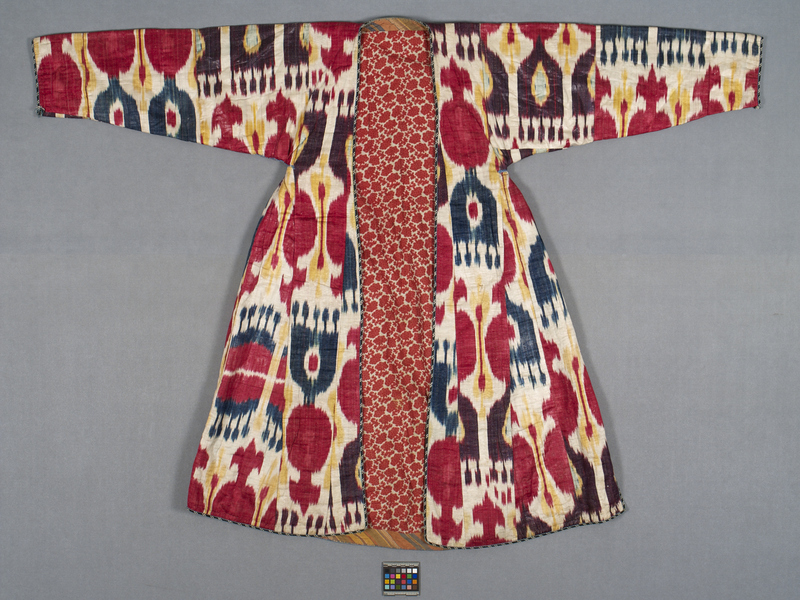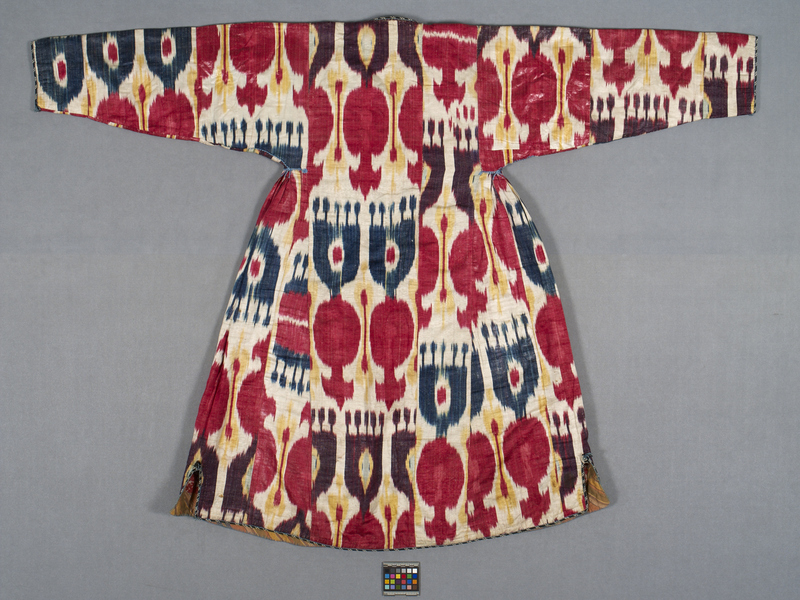Coat Item Number: 3231/21 from the MOA: University of British Columbia


Description
Woman’s full-length, A-line, colourful robe or coat (chapan), with long tapered sleeves; open from neck to hem at centre front, no fasteners; made of red, yellow, green-blue, purple and white warp-ikat textile (silk warp, cotton weft), with glazed surface. Lightly quilted with a light layer of cotton batting. Gathering at the sides just under the sleeves. 12 cm slits at each side at the hem. All edges trimmed with narrow black, blue and white braid made with loop manipulation technique. Lined with red and off-white machine printed cotton textile, representing bunches of flowers; sleeve fronts lined with green, red and off-white machine printed cotton textile, representing leaves and paisleys; all edges are faced on the inside with bias strips of multi-coloured woven striped cotton textile.
History Of Use
Ikat robes were worn by men, women and children of various ethnic groups. Women’s robes incorporate extra fullness under the sleeves, for wearing ease, and the front opening is typically wide at the chest area, in order to show the lavish jewelry that women often wore. Robes were worn on top of a shirt, tunic or dress and with wide drawstring pants. Several robes may have been worn at once, layered one over another, to display rank and/or wealth. The colourful printed cotton textiles which were typically used to line robes made in Central Asia were manufactured in Russia for the Central Asian market, as was the striped bias-cut cotton textile that was used as facings on all the edges (called the lapse). Following the Russian Revolution, the workshops that made ikat robes like this one, which had been organized around family and social networks, were disbanded by the Soviet government, replaced by collective practices in factories. Eventually the making and wearing of ikat robes disappeared.
Specific Techniques
Warp-faced ikat technique. The decorative trim on this robe was produced by a loop manipulation technique, which requires two people working together. One worker holds multiple loops of thread, of various colours, under tension with his fingers, creating warp sheds that are switched between the fingers of one hand and those of the other hand, while another worker inserts a weft into each shed and attaches the threads down onto the surface of the garment with a needle. The result is a multicoloured band with a repeated pattern.
Iconographic Meaning
Ram’s horn motifs represent the warding off of spirits. The decorative braid or embroidery on all outside edges of ikat robes was believed to be an essential part of the garment, as it prevented evil spirits from infecting the wearer.
Narrative
Joanna Staniszkis purchased this robe and most other robes in the 3231 accession in Istanbul, shortly after the dissolution of the USSR; the robes had been previously stored in trunks for a considerable length of time.
Item History
- Made in Uzbekistan before 1900
- Collected in Istanbul, Turkey during 1991
- Owned by Joanna Staniszkis before March 20, 2017
- Received from Joanna Staniszkis (Donor) on March 20, 2017
What
- Name
- Coat
- Identification Number
- 3231/21
- Type of Item
- coat
- Material
- silk fibre, dye and cotton fibre
- Manufacturing Technique
- calendered and warp-faced ikat
- Overall
- height 122.5 cm, width 167.0 cm
Who
- Culture
- Uzbek
- Previous Owner
- Joanna Staniszkis
- Received from
- Joanna Staniszkis (Donor)
Where
- Holding Institution
- MOA: University of British Columbia
- Made in
- Uzbekistan
- Collected in
- Istanbul, Turkey
When
- Creation Date
- before 1900
- Collection Date
- during 1991
- Ownership Date
- before March 20, 2017
- Acquisition Date
- on March 20, 2017
Other
- Item Classes
- textiles
- Condition
- good
- Accession Number
- 3231/0021